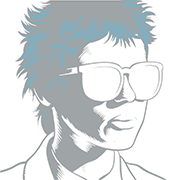I met Laurie Anderson in early 2006, when I invited her to participate in a literary and music series I run and host in New York, called “Happy Ending.” I ask the artists to do something they’ve never done before—to take a risk onstage. The risk she chose was to tell a story through PowerPoint presentation. The audience was completely enthralled, but when I reminded her about her risk in our interview, she was mortified. Hosting in front of Laurie Anderson felt like a personal risk for me: she is one of my artistic heroes. But the instant we shook hands that night, she put me at ease with her ease. I carried that onto the stage, and the show went well.
Born in Chicago in 1947, Anderson quickly found her place in the experimental art scene of 1970s SoHo. Her first performances were spectacles: a symphony of car horns at a drive-in bandshell, a violin concert in which she wore skates frozen into slowly melting blocks of ice. Her reputation in America and Europe quickly grew, and, less than a decade into her career, the New York Times recommended her live performances to “anyone remotely interested in where American art is going,” calling her “the best and most popular performance artist of her age.” Her work has been described as “avant-garde pop,” “cryptic yet warmly accessible,” “popular, but epic; showbiz, but avant-garde,’’ and “entirely idiosyncratic.” By age thirty-five, Anderson possessed something very rare in performance-art circles—mainstream popularity—when her rock single, “O Superman,’’ reached number two on the British charts.
For four decades, she has created work that employs a variety of media: sculpture, music, video, spoken narrative, projected imagery. She has scored orchestral compositions and invented musical instruments, including the “tape-bow violin” (on which recorded magnetic tape replaces the horsehair in the bow and bridge) and the “talking stick,” a wireless device that can access and produce any sound. She has published books, released seven albums on the Warner label, shown at major museums, and was employed as NASA’s first artist-in-residence. She has said that she feels her sensibility is “closer to the attitude of the stand-up comedian… not only because I believe that laughter is extremely powerful but because the comedian works in real time.”
I visited Laurie Anderson at her Canal Street studio overlooking the Hudson River. She sat there, comfortably barefoot, asking perhaps even more questions of me than I asked of her.
—Amanda Stern
I. “AM I IN A STRUCTURE OR JUST A DIAGRAM OF A STRUCTURE?”
LAURIE ANDERSON: I did a show inspired by Alain de Botton—he has something called “The School of Life” in London. It’s a really wonderful storefront, and...
You have reached your article limit
Sign up for a digital subscription and continue reading all new issues, plus our entire archives, for just $1.50/month.
Already a subscriber? Sign in





